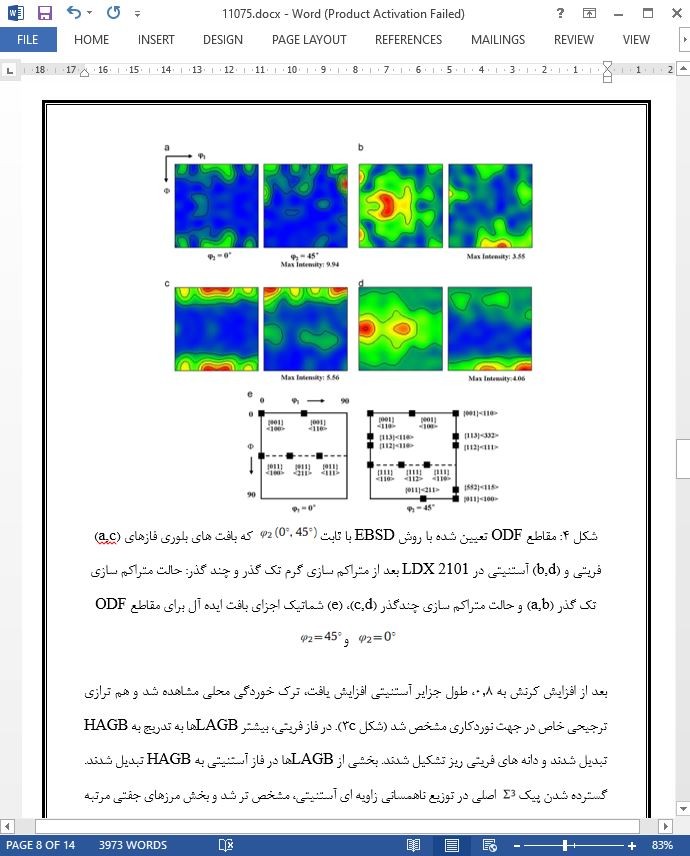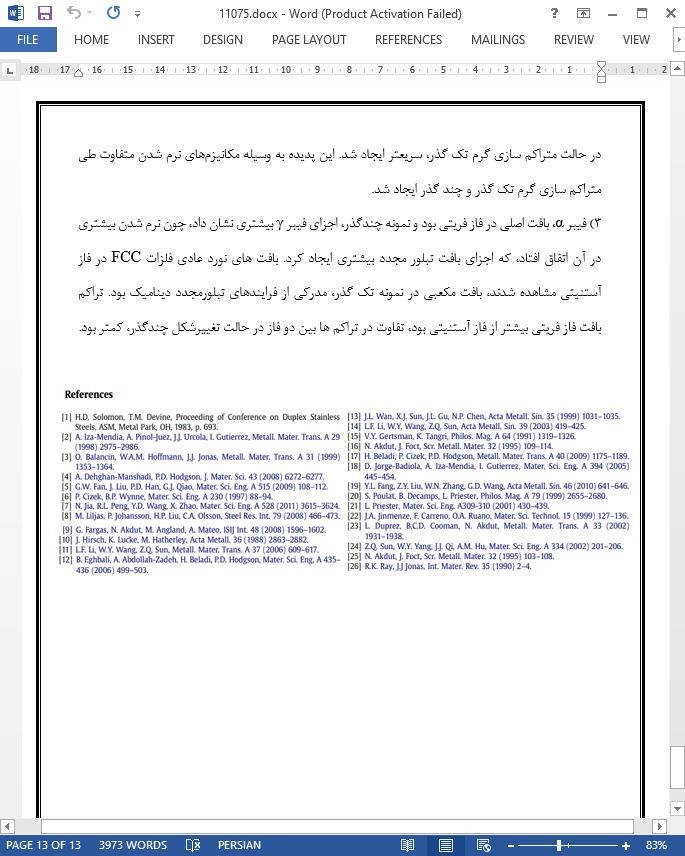
تاثیر حالت تغییرشکل گرم بر تغییر میکروساختار فولاد ضدزنگ دوپلکس ضعیف 2101
چکیده
تغییر میکروساختار و بافت کریستالوگرافی فولاد ضدزنگ دوپلکس ضعیف 2101 (LDX 2101) طی متراکمسازیِ گرم تک¬گذر و چندگذر به وسیله پراش الکترون های برگشتی (EBSD) مطالعه شد. مشخصات منحنی جریان LDX 2101 به وسیله رفتارهای اتصال تغییر میکروساختار در فازهای آستنیتی و فریتی تفسیر شد. نرم شدن دوفاز طی کرنش، با تبلور مجدد دینامیکی پیوسته به وسیله تبدیل تدریجی مرزدانه ها با زاویه کوچک به مرزدانه ها با زاویه بزرگ و بدون تغییر در نسبت فاز ایجاد می¬شود. بافتهای متراکمسازی گرم فازهای تشکیل دهنده نشان میدهد که بافت نوع برنجی که در مواد مکعبی مراکز وجوه پر با انرژی گسلش انباشتی، به صورت عادی وجود دارد، در فاز آستنیتی ایجاد می شود و بافت مکعبی چرخشی در فاز فریتی ایجاد می شود. تفاوت در ویژگی های میکروساختارها و تغییر بافتی تحت حالات تغییرشکل گرم متفاوت را می توان با تفاوت در مکانیزم های نرم شدن توضیح داد.
1. مقدمه
فولاد ضدزنگ دوپلکس (DSS) به وسیله ساختار فاز دوتایی شامل مخلوطی از فازهای فریت و آستنیت مشخص میشود. DSS به دلیل ویژگیهای مکانیکی و عملکرد خوردگی عالی، کاربرد بسیاری در صنایع شیمیایی، پتروشیمی، هسته ای، دریایی و کاغذسازی دارد.
DSS را می توان به وسیله روندهای مختلف مانند ریخته گری، آهنگری، اکستروژن یا نورد، فرآوری کرد. این روندها معمولا در دمای بالا انجام می شوند که DSS هنوز بافت دوپلکس دارد. اما ضرایب رفتار تغییرشکل حرارتی متفاوت هر فاز تشکیل دهنده (آستنیت یا فریت) تحت تاثیر حضور فاز دیگر در شرایط گرم کاری هستند که باعث ترک خوردگی در لبه یا پرداخت سطحی نامناسب می شود.
5. نتیجه گیری
LDX 2101 تحت تغییرشکل گرم در حالات تغیرشکل متفاوت قرار گرفت. تغییر میکروساختار و مشخصات بافت کریستالوگرافی با استفاده از روش EBSD مطالعه شدند. این نتیجه گیری ها به دست آمدند:
1) طی متراکم سازی گرم، با بیشتر شدن کاهش، مورفولوژی فاز آستنیتی از ساختار با محورهای موازی به ساختار نوار طویل تغییر کرد و مرزدانه های به تدریج ناپدید شدند. کسرهای حجمی آستنیت و فریت که در ابتدا تقریبا برابر بودند، بدون تغییر باقی ماندند و تبلور مجدد دینامیکی پیوسته در فازهای فریت و آستنیت اتفاق افتاد.
Abstract
Microstructure and crystallographic texture evolution of lean duplex stainless steel 2101 (LDX 2101) during single- and multi-pass hot compressions were studied by electron backscatter diffraction (EBSD). The flow curve characteristics of LDX 2101 were interpreted by coupling behaviors of the microstructure evolution in austenitic and ferric phases. The softening of both the phases during straining is caused by continuous dynamic recrystallization by the gradual transformation of low-angle grain boundaries into high-angle grain boundaries, without obvious changes in the phase ratio. The hot compression textures of the constituent phases show that the brass-type texture, which is typical of face-centered cubic materials with low stacking fault energy, is developed in the austenitic phase, and the rotated-cube texture is developed in the ferric phase. The differences in the microstructures and texture evolution features under different hot deformation modes can be explained by the differences in softening mechanisms.
1. Introduction
Duplex stainless steel (DSS) is characterized by a dual phase structure comprising a mixture of ferric and austenitic phases. DSS is increasingly employed in chemical, petrochemical, nuclear, marine, and paper industries primarily because of its excellent mechanical properties and corrosion performance [1].
DSS can be processed through different procedures, such as casting, forging, extrusion or rolling. These procedures are usually performed at high temperatures where the DSS still possesses a duplex structure. However, the different thermal deformation behavior coefficients of each constituent phase (austenite or ferrite) are considerably affected by the presence of the other phase under hot working conditions, which leads to edge cracks or inappropriate surface finish [2].
5. Conclusions
LDX 2101 was subjected to hot deformation under different deformation modes. The evolution of microstructure and crystallographic texture characteristics was studied using the EBSD technique. The following conclusions were drawn.
(1) During hot compression, as the reduction increased, the morphology of the austenitic phase changed from equiaxed to elongated ribbon structure, and the original ∑3 grain boundaries gradually disappeared. The starting approximately equal volume fractions of austenite and ferrite remained unchanged, and typical continuous dynamic recrystallization occurred in both ferric and austenitic phases.
چکیده
1. مقدمه
2. روند آزمایشی
3. نتایج
3.1 مشخصات منحنی جریان
3.2 تغییر میکروساختار
3.3 بافت کریستالوگرافی
4. بحث
4.1 تغییر میکروساختاری فاز فریتی
4.2 تغییر میکروساختار فاز آستنیتی
4.3 تغییرشکل تراکم پذیر دوفازی و حالات تغییرشکل متفاوت
4.4 تغییر بافت کریستالوگرافی
5. نتیجه گیری
Abstract
1. Introduction
2. Experimental procedure
3. Results
3.1. Flow curve characteristics
3.2. Microstructure evolution
3.3. Crystallographic texture
4. Discussion
4.1. Microstructural evolution of the ferric phase
4.2. Microstructure evolution of the austenitic phase
4.3. Two-phase compatible deformation and effects of different deformation modes
4.4. Crystallographic texture evolution
5. Conclusions
- اصل مقاله انگلیسی با فرمت ورد (word) با قابلیت ویرایش
- ترجمه فارسی مقاله با فرمت ورد (word) با قابلیت ویرایش، بدون آرم سایت ای ترجمه
- ترجمه فارسی مقاله با فرمت pdf، بدون آرم سایت ای ترجمه



